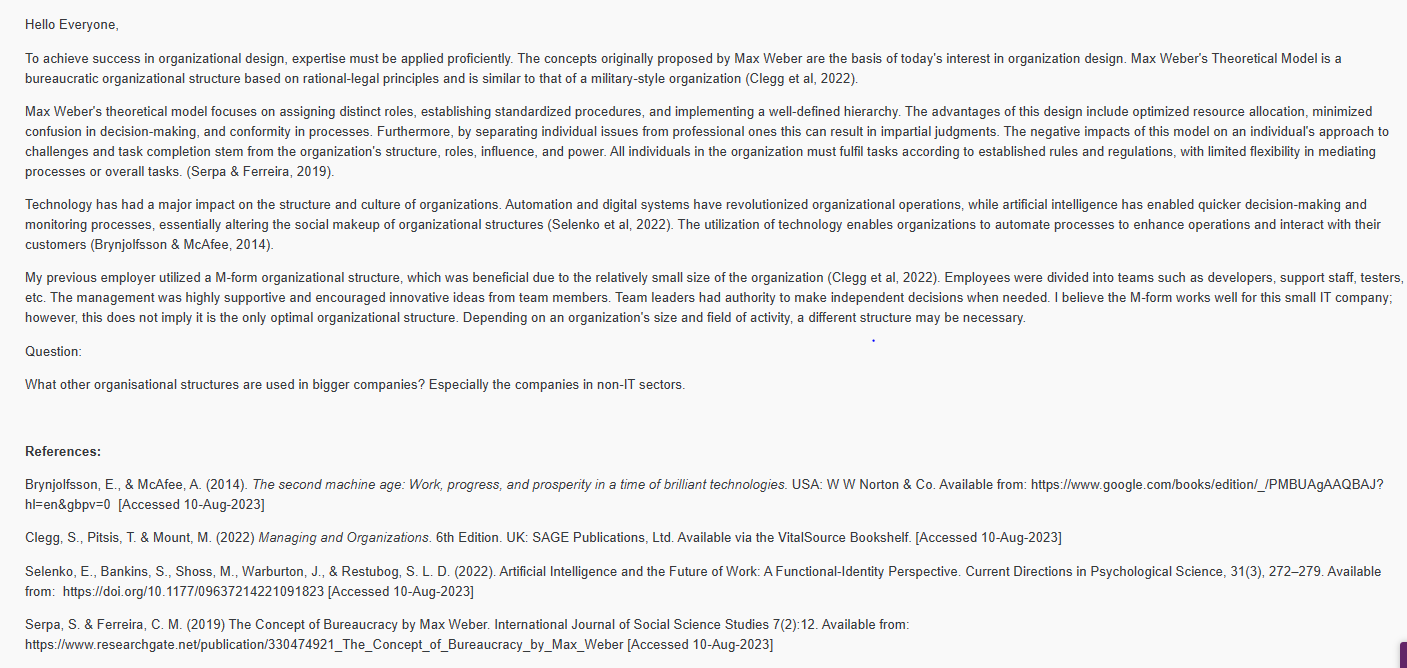Question
- I need to replay/ Respond for the following discussion below. - 200-300 words - Harvard System Reference - Support the replay with a References
- I need to replay/ Respond for the following discussion below.
- 200-300 words
- Harvard System Reference
- Support the replay with a References from your own and examples and experiences. ( 3 References)
- References to be within the UK
The discussion:
Hello Everyone,
To achieve success in organizational design, expertise must be applied proficiently. The concepts originally proposed by Max Weber are the basis of today's interest in organization design. Max Weber's Theoretical Model is a bureaucratic organizational structure based on rational-legal principles and is similar to that of a military-style organization (Clegg et al, 2022).
Max Weber's theoretical model focuses on assigning distinct roles, establishing standardized procedures, and implementing a well-defined hierarchy. The advantages of this design include optimized resource allocation, minimized confusion in decision-making, and conformity in processes. Furthermore, by separating individual issues from professional ones this can result in impartial judgments. The negative impacts of this model on an individual's approach to challenges and task completion stem from the organization's structure, roles, influence, and power. All individuals in the organization must fulfil tasks according to established rules and regulations, with limited flexibility in mediating processes or overall tasks. (Serpa & Ferreira, 2019).
Technology has had a major impact on the structure and culture of organizations. Automation and digital systems have revolutionized organizational operations, while artificial intelligence has enabled quicker decision-making and monitoring processes, essentially altering the social makeup of organizational structures(Selenko et al, 2022).The utilization of technology enables organizations to automate processes to enhance operations and interact with their customers (Brynjolfsson & McAfee, 2014).
My previous employer utilized a M-form organizational structure, which was beneficial due to the relatively small size of the organization (Clegg et al, 2022). Employees were divided into teams such as developers, support staff, testers, etc. The management was highly supportive and encouraged innovative ideas from team members. Team leaders had authority to make independent decisions when needed. I believe the M-form works well for this small IT company; however, this does not imply it is the only optimal organizational structure. Depending on an organization's size and field of activity, a different structure may be necessary.
Question:
What other organisational structures are used in bigger companies? Especially the companies in non-IT sectors.
References:
Brynjolfsson, E., & McAfee, A. (2014).The second machine age: Work, progress, and prosperity in a time of brilliant technologies.USA: W W Norton & Co. Available from: https://www.google.com/books/edition/_/PMBUAgAAQBAJ?hl=en&gbpv=0 [Accessed 10-Aug-2023]
Clegg, S., Pitsis, T. & Mount, M. (2022)Managing and Organizations. 6th Edition. UK: SAGE Publications, Ltd. Available via the VitalSource Bookshelf.[Accessed 10-Aug-2023]
Selenko, E., Bankins, S., Shoss, M., Warburton, J., & Restubog, S. L. D. (2022). Artificial Intelligence and the Future of Work: A Functional-Identity Perspective. Current Directions in Psychological Science, 31(3), 272-279. Available from: https://doi.org/10.1177/09637214221091823 [Accessed 10-Aug-2023]
Serpa, S. & Ferreira, C. M. (2019) The Concept of Bureaucracy by Max Weber.International Journal of Social Science Studies 7(2):12. Available from: https://www.researchgate.net/publication/330474921_The_Concept_of_Bureaucracy_by_Max_Weber [Accessed 10-Aug-2023]

Step by Step Solution
There are 3 Steps involved in it
Step: 1

Get Instant Access to Expert-Tailored Solutions
See step-by-step solutions with expert insights and AI powered tools for academic success
Step: 2

Step: 3

Ace Your Homework with AI
Get the answers you need in no time with our AI-driven, step-by-step assistance
Get Started


